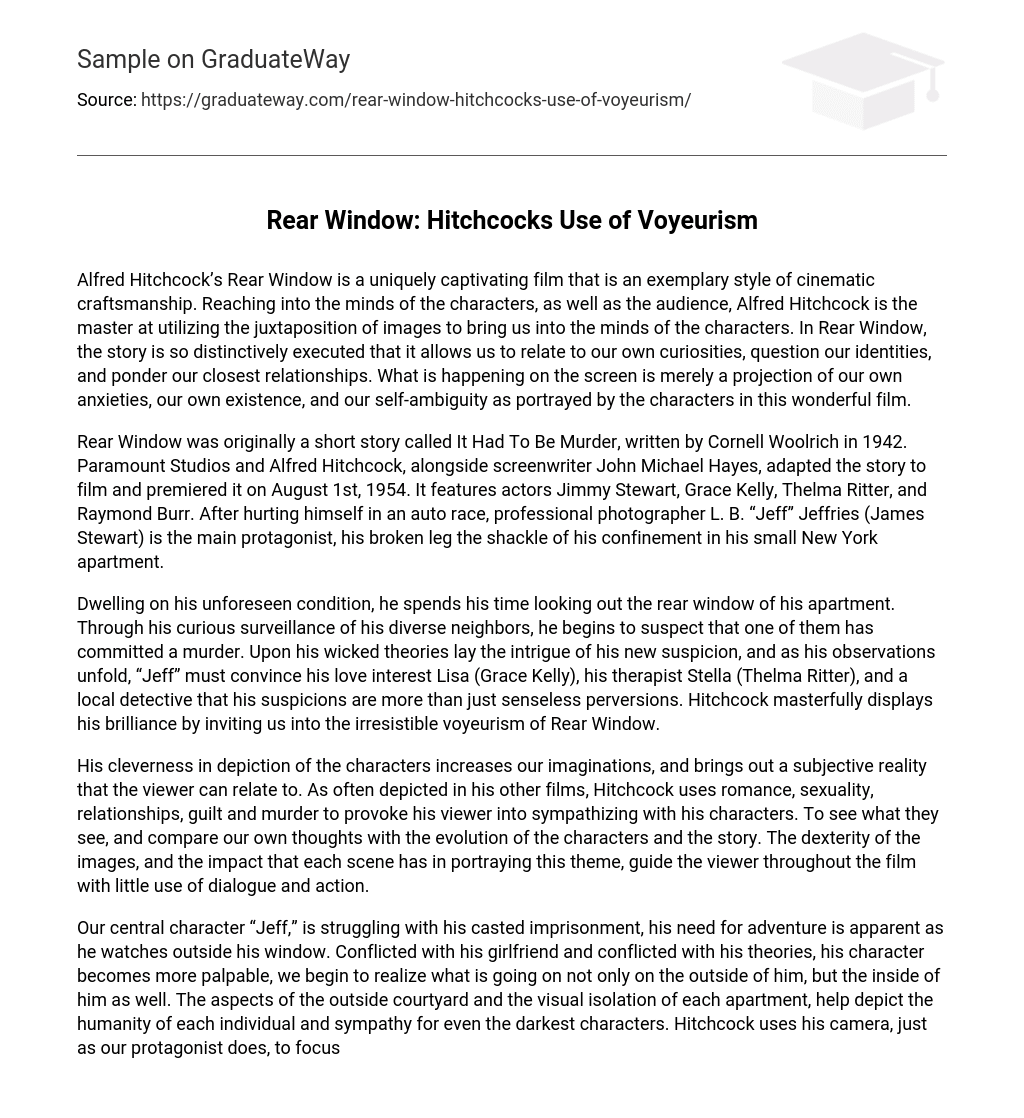Alfred Hitchcock’s Rear Window is a uniquely captivating film that is an exemplary style of cinematic craftsmanship. Reaching into the minds of the characters, as well as the audience, Alfred Hitchcock is the master at utilizing the juxtaposition of images to bring us into the minds of the characters. In Rear Window, the story is so distinctively executed that it allows us to relate to our own curiosities, question our identities, and ponder our closest relationships. What is happening on the screen is merely a projection of our own anxieties, our own existence, and our self-ambiguity as portrayed by the characters in this wonderful film.
Rear Window was originally a short story called It Had To Be Murder, written by Cornell Woolrich in 1942. Paramount Studios and Alfred Hitchcock, alongside screenwriter John Michael Hayes, adapted the story to film and premiered it on August 1st, 1954. It features actors Jimmy Stewart, Grace Kelly, Thelma Ritter, and Raymond Burr. After hurting himself in an auto race, professional photographer L. B. “Jeff” Jeffries (James Stewart) is the main protagonist, his broken leg the shackle of his confinement in his small New York apartment.
Dwelling on his unforeseen condition, he spends his time looking out the rear window of his apartment. Through his curious surveillance of his diverse neighbors, he begins to suspect that one of them has committed a murder. Upon his wicked theories lay the intrigue of his new suspicion, and as his observations unfold, “Jeff” must convince his love interest Lisa (Grace Kelly), his therapist Stella (Thelma Ritter), and a local detective that his suspicions are more than just senseless perversions. Hitchcock masterfully displays his brilliance by inviting us into the irresistible voyeurism of Rear Window.
His cleverness in depiction of the characters increases our imaginations, and brings out a subjective reality that the viewer can relate to. As often depicted in his other films, Hitchcock uses romance, sexuality, relationships, guilt and murder to provoke his viewer into sympathizing with his characters. To see what they see, and compare our own thoughts with the evolution of the characters and the story. The dexterity of the images, and the impact that each scene has in portraying this theme, guide the viewer throughout the film with little use of dialogue and action.
Our central character “Jeff,” is struggling with his casted imprisonment, his need for adventure is apparent as he watches outside his window. Conflicted with his girlfriend and conflicted with his theories, his character becomes more palpable, we begin to realize what is going on not only on the outside of him, but the inside of him as well. The aspects of the outside courtyard and the visual isolation of each apartment, help depict the humanity of each individual and sympathy for even the darkest characters. Hitchcock uses his camera, just as our protagonist does, to focus with him.
The camera angles are depicted in a way to which we react with the character, rather than at the character, and eventually expose the minor elements of the story that bring to fruition the suspense of the movie and the thrills of discovery. Rear Window is compelling, clever, and utterly original. Hitchcock helps us share this obsessive curiosity, and draw our conclusions directly parallel to the characters in the film. The unique montage of imagery helps define our characters, and expose their vulnerability, their identity, and their own self-discovery in a manner that is not only unique but also effective.
Alfred Hitchcock constructs his art form with the utmost precision; this complexity lends its way to the simplicity of the story, and helps the viewer understand the characters, and absorb the emotion looking through the same window.
Works Cited
Rear Window. Dir. Alfred Hitchcock. Perf. James Stewart, Grace Kelly, Thelma Ritter, Raymond Burr. Paramount Pictures, 1954. Collectors Edition, Universal Pictures, 2001. DVD. “Rear Window (1954)” Internet Movie Database. 1990-2011. 14 February 2011.





